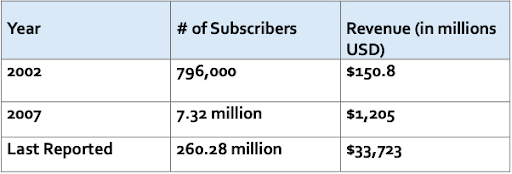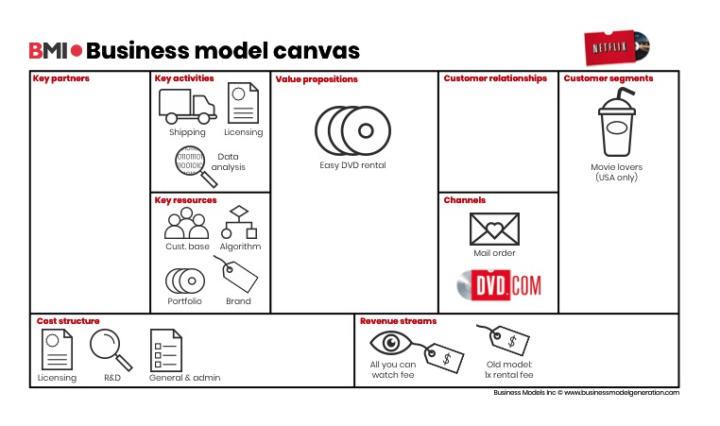
How Netflix Moved Operations to the Cloud and Saw Revenue Boom: A Digital Transformation Case Study
Remember the days when you had a wait for a DVD to arrive in the mail to watch your favorite movie? It’s hard to imagine, right?
It’s strange to think that about a decade ago, streaming giant Netflix had a business model built around direct mail.
Request a movie, put a few in your queue for next time, and let the anticipation build as you wait for your first DVD to arrive on your doorstep.
Now, our instant gratification bells ring daily as we pour through episode after episode of new material. And, we can barely remember the (dark) time where we waited days for entertainment instead of having it literally at our fingertips.
This monumental shift from mail-in orders to a cloud-based streaming service improved customer satisfaction and propelled Netflix into a multi-billion dollar enterprise. Furthermore, by embracing customer-based AI analytics, Netflix fostered high customer loyalty and established a brand that competitors still strive to surpass.
Just as Netflix harnessed cloud technology and AI to revolutionize its operations, your contact center can leverage automation tools to enhance efficiency and improve customer experiences (CX). With Sharpen’s AI solutions, you can streamline communication, reduce response times, and empower your agents with actionable insights.
Embrace the digital transformation that elevates customer interactions and secures your position as a leader in your industry.
How to move your operations to the cloud, Netflix style: A digital transformation case study.
Over 20 years after they started renting DVDs, Netflix now sits at a valuation of almost $320 Billion. They came to market as a disruptor of traditional video stores like Blockbuster and Family Video.
Founders Reed Hastings and Marc Randolph were committed to customer-centricity, envisioning a video rental model free of inconvenient store trips and costly late fees. By introducing DVD-by-mail and later pioneering streaming, Netflix fundamentally changed how people consumed content—adapting to digital innovation and putting customer experience at the forefront.
In 2007, Netflix launched its first streaming service, letting customers choose between streaming and traditional DVD rentals. This flexible model exemplified their commitment to convenient, customer-focused service—a strategy that fueled exponential growth in both subscribers and revenue.
Here’s how Netflix has grown since 2002.

That incredible growth trajectory, and willingness to change, made Netflix stock skyrocket by 6,230% in a 10-year period.
And, they did it all without crazy price hikes, keeping customers top-of-mind.
While Netflix has adjusted prices over the years, they strike a balance by adding more value and services for the dollar. In 2019, the Basic plan increased by $1 a month (adding up to $12 annually). While the Standard and Premier plans rose by $2 per month, (adding up to $24 annually, for each plan).
Meanwhile, the company is putting some $15 billion towards creating new content binge-watchers will love.
For contact centers, Netflix’s journey highlights the importance of digital innovation to enhance customer experience. By focusing on automation strategies that enhance CX, such as usable AI personalization, contact centers can achieve new heights in service quality, efficiency, and loyalty—paralleling Netflix’s own journey of success.
Stay true to your vision.
Netflix started out with the idea to make it easier and less expensive for people to watch movies.

But they didn’t want to stay in the DVD game forever. They had the foresight to predict that consumer behaviors would continue to shift. And, they wanted to stay ahead of the competition.
Only, they didn’t sacrifice their vision when it came time for company-wide changes. Instead, they realigned their business strategies to fit their vision, even as consumers and trends shifted.
What you can do:
As you make shifts to AI technology in your contact center, Sharpen’s platform provides the insights you need to maintain a cohesive vision. Let your brand values steer every decision, and, use data and trends from Sharpen’s predictive analytics to predict how your customer behavior will shift. By tracking trends in real-time, your contact center can make proactive adjustments, keeping customer needs at the forefront.
As you keep pace with your customers’ needs, align your operations to your customer behaviors to realize your vision.
Reinvent the wheel if the old one doesn’t solve customer problems.
Netflix soared from seed idea to a $145-billion-dollar valuation in only 21 years. (Wow, they did that in less time than it took big tech vendors to break CSAT scores.)
And they didn’t get there by spinning up a new-and-improved version of Blockbuster.
The company leaders didn’t stick to traditional best practices because they no longer worked for modern customers.
Instead of piggybacking off what other companies did, Netflix solved problems differently. And, they solved them better.
What you can do:
Like Netflix’s move to understand its viewers better, Sharpen’s platform allows you to gather actionable customer insights from every interaction. AI tools empower agents to identify recurring pain points and common queries, enabling agents to approach calls with a clearer understanding of each customer’s journey. This data-driven approach helps tailor solutions that align with customers’ individual preferences and experiences, transforming reactive support into proactive service.
Don’t get caught up in what your competition is doing. What they’re doing might work, but your actionable data and customer information can guide you to a way that works better.
If you’re going to be consumed by one thought, let it be this one: how might we better serve our customers?
Don’t force your customers down a single path.
In the early phases of Netflix, internet speeds weren’t built for streaming movies. People who tried to download and view movies online were only frustrated by the lengthy, often interrupted experience of watching a film online.
Netflix didn’t want to enter the streaming market until the right infrastructure was available to support a platform with high-quality and high-speed content. They didn’t want to taint their brand from day one, linking the Netflix name to all the baggage that came with poor streaming experiences.
At the same time, they were watching postage prices. The price of postage kept rising, and internet speeds were on the ups. By watching how the market and internet infrastructure changed, they identified the right moment to launch their first streaming service.
What you can do:
Your contact center and customer experience will change. It has to. But as you make changes and shift your operations to the AI era, keep options open for your customers.
Customers have diverse preferences; some might prefer quick live chats, while others seek the personal touch of a phone call. Use AI-driven insights on past data and communication history to learn more about your customers. Then, coach your agents to handle each interaction based on the customer’s preferences.
Bringing changes to your contact center through Artificial Intelligence has the potential to transform your customer experience for the better. But, without careful intention, it can also cause friction. Introduce changes to your customers slowly, and make sure your agents are always there to offer extra help through the process.
Use data and trends to personalize your customer experiences.
This one’s huge. It’s how Netflix keeps customers engaged with their platform, and how they coined the term binge-watching.
As Netflix made changes in their operations, they watched their data like a hawk. They looked for trends on how people watched content, what kept them watching, and how personalization fueled content absorption. Then, they used a customer-focused AI algorithm to serve up content tailored to their customers’ specific interests.
“Like a helpful video-store clerk, it recommended titles viewers might like based on others they’d seen.” – Twenty Years Ago, Netflix.com Launched. The Movie Business Has Never Been the Same, by Ashley Rodriguez for Quartz.
What you can do:
Track and analyze data from your customer interactions. Embracing data for decision-making empowers your organization to evolve. Sharpen’s custom dashboards and reports allow you to monitor KPIs in real-time and quickly identify areas for improvement. If metrics show a drop in satisfaction, your leaders are equipped with the insights they need to make adjustments.
Netflix took risks to transform their business. Sharpen’s AI call center solutions can similarly position your contact center as an industry leader by allowing you to experiment with new methods for engagement and service delivery. Stagnation poses a bigger risk than innovation; using AI to test and implement forward-thinking ideas keeps your organization competitive.
Ready to transform your customer service with contact center AI automation tools? Schedule a consultation with Sharpen today to learn more.
Can your tech vendor survive in your digital transformation?
Learn how to choose vendors who make your transformation strategy possible.

